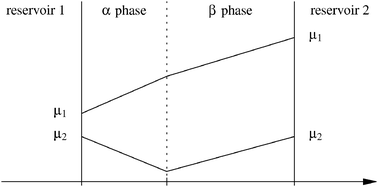Coupled transport processes in responding membranes: the case of a single gradient
Abstract
We present a theoretical study of two coupled diffusion processes through a membrane which is able to respond to the presence of the diffusing substances with a phase change. The case we consider is when the direct driving force for one of the processes vanishes, i.e. when the chemical potential of one of the components, or some other intensive variable, is kept equal in the two reservoirs surrounding the membrane. The coupling of the two transport processes results in non-zero gradients inside the membrane also for the variable that is equal in the two reservoirs. There is a concomitant change in the phase coexistence compared to the behaviour expected if only considering the external conditions. The transport properties of the two phases within the membrane have to be different for this effect to occur, but otherwise the prerequisites are rather general. An analogous effect is expected for the case of coupled diffusion and heat conduction. Amphiphilic systems or biological membranes often show large changes in structure and transport properties due to small variations in thermodynamic variables such as temperature, the osmotic pressure of the


 Please wait while we load your content...
Please wait while we load your content...